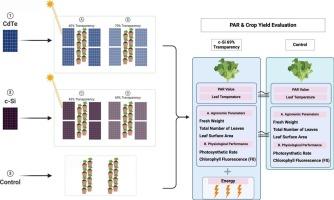在受控环境中使用均匀/非均匀半透明光伏组件种植农用生菜的透明度效应
IF 6
2区 工程技术
Q2 ENERGY & FUELS
引用次数: 0
摘要
农业光伏系统通过整合粮食和能源生产,为土地限制提供了一种双重用途的解决方案,然而,人们对光照分布特征(尤其是均匀性)对作物性能的影响仍然知之甚少。本研究研究了生菜在两种不同的农业光伏照明策略下的生理和产量响应,同时保持相当的透明度:(1)碲化镉(CdTe)薄膜光伏(PV)组件的均匀照明和(2)双面晶硅(c-Si)光伏组件的非均匀照明,电池和玻璃区域交替。实验使用40%、50%和70%透明度的CdTe模块和44%和69%透明度的双面c-Si模块进行。测量的关键参数包括光合有效辐射(PAR)、气体交换指标(光合速率、气孔导度、细胞间CO2、蒸腾)和形态性状(株高、叶数、鲜重)。结果表明,69%透明c-Si模块不仅使保存莴苣的产量相对于露地对照提高了3.6%。相反,类似透明度的CdTe模块导致产量降低6%,强调了光不均匀性在优化植物响应中的重要性。这些发现表明,c-Si系统的空间光异质性可以提高作物性能,为可持续集约化提供了机会。在加拿大的莴苣种植区推广这项技术可以产生1200兆瓦的太阳能,同时每年增加2000万加元的农业收入,另外还有3000万加元的太阳能土地租赁收入。这项研究支持非均匀的、半透明的光伏模块的集成,作为通往可持续未来的协同能源-农业系统的可行途径。本文章由计算机程序翻译,如有差异,请以英文原文为准。

Transparency effects in agrivoltaics lettuce cultivation using uniform/non-uniform semitransparent photovoltaic modules in controlled environments
Agrivoltaic systems offer a dual-use solution to land constraints by integrating food and energy production, yet the influence of light distribution characteristics—particularly uniformity—on crop performance remains poorly understood. This study investigates the physiological and yield responses of lettuce under two contrasting agrivoltaic lighting strategies while maintaining comparable transparency: (1) uniform illumination from cadmium telluride (CdTe) thin-film photovoltaic (PV) modules and (2) non-uniform illumination from bifacial crystalline silicon (c-Si) PV modules with alternating cell and glass regions. Experiments were conducted using CdTe modules at 40 %, 50 %, and 70 % transparency and bifacial c-Si modules at 44 % and 69 % transparency. Key parameters measured include photosynthetically active radiation (PAR), gas exchange metrics (photosynthesis rate, stomatal conductance, intercellular CO2, transpiration), and morphological traits (plant height, leaf count, fresh weight). Results reveal that 69 % transparent c-Si modules not only preserved lettuce yield relative to open-field controls but achieved a 3.6 % enhancement. Conversely, CdTe modules of similar transparency caused a 6 % yield reduction, underscoring the importance of light non-uniformity in optimizing plant response. These findings demonstrate that spatial light heterogeneity – characteristic of c-Si systems – can enhance crop performance, presenting an opportunity for sustainable intensification. Scaling this technology across Canada’s lettuce-growing regions could generate 1,200 MW of solar power while boosting agricultural revenue by CAD $20 million annually, with an additional CAD $30 million from solar land leasing. This study supports the integration of non-uniform, semi-transparent PV modules as a viable pathway toward synergistic energy-agriculture systems for a sustainable future.
求助全文
通过发布文献求助,成功后即可免费获取论文全文。
去求助
来源期刊

Solar Energy
工程技术-能源与燃料
CiteScore
13.90
自引率
9.00%
发文量
0
审稿时长
47 days
期刊介绍:
Solar Energy welcomes manuscripts presenting information not previously published in journals on any aspect of solar energy research, development, application, measurement or policy. The term "solar energy" in this context includes the indirect uses such as wind energy and biomass
 求助内容:
求助内容: 应助结果提醒方式:
应助结果提醒方式:


